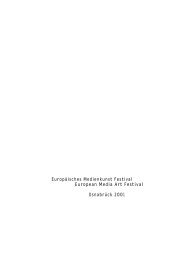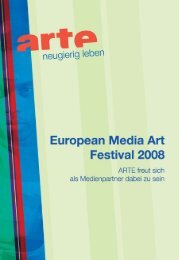EUROPEAN MEDIA ART FESTIVAL OSNABRUECK 2011 - Emaf
EUROPEAN MEDIA ART FESTIVAL OSNABRUECK 2011 - Emaf
EUROPEAN MEDIA ART FESTIVAL OSNABRUECK 2011 - Emaf
Create successful ePaper yourself
Turn your PDF publications into a flip-book with our unique Google optimized e-Paper software.
›SO CLOSE IN THE DISTANCE‹<br />
curated by Charlotte Bank<br />
The recent revolutions in Egypt and Tunisia came as a surprise for large parts of the European public. For so<br />
long, we have been used to seeing the countries of the Arab world presented as unchangeable, traditionalist societies;<br />
suddenly, however, images of young people who demanded individual freedom, improved chances, an<br />
end to corruption and democratic reforms reached our media. This seemed in no way to fit into the usual Western<br />
perception of the region.<br />
Thereby, the distance between the young people and those in power in the Arab world has long given rise to<br />
great frustrations. The percentage of young people in all countries of the region is very high, yet up till now they<br />
had no influence on political decisions and were hardly regarded as a social force to be reckoned with. Unemployment<br />
rates among the youth are high, even among well educated people, but no country has developed<br />
strategies to cope with this problem. As a result, a general feeling of disappointment and hopelessness was<br />
widespread.<br />
The works of young artists mirror these concerns. From a critical angle, they investigate a wide range of sociocultural<br />
and socio-political issues, often also addressing sensitive taboos. Video has proven itself a useful tool<br />
for this movement and has become one of the most important artistic media since the late 1990s. Mobile and<br />
affordable, its activist potential proved particularly attractive. The artist, no longer confined to a studio and<br />
aloof from society, was now able to take his/her art onto the streets and address issues of relevance for the entire<br />
society. For a generation who often enough felt they could do nothing about inacceptable conditions, this<br />
was welcomed as an important asset. It also explains the prominence of narrative and documentary content in<br />
many works.<br />
Arab video art is characterized by a great variety of aesthetic approaches and is highly dynamic in character<br />
and changing constantly. Works reveal references to international auteur cinema, as well as citations of American<br />
trash movies, Hollywood classics, music videos and TV series. Found footage and archival material is also<br />
used to a high degree. The thematic scope reflects the social and political reality of the countries of production.<br />
Lebanese and Palestinian videos often deal with war, civil war and occupation and its consequences, Syrian<br />
and Egyptian works largely comment on social rigidity and moral narrow-mindedness. In the Maghreb, colonialism<br />
and migration are central themes and videos of Arab diaspora artists often examine the complex issues<br />
of exile, foreignness and question the mechanisms of racism and stigmatization.<br />
The videos of this program were produced in the middle and end of the last decade. They are testimony to the<br />
social engagement of young Arab artists, an engagement also demonstrated through the active participation of<br />
these artists in the revolutions.<br />
95












